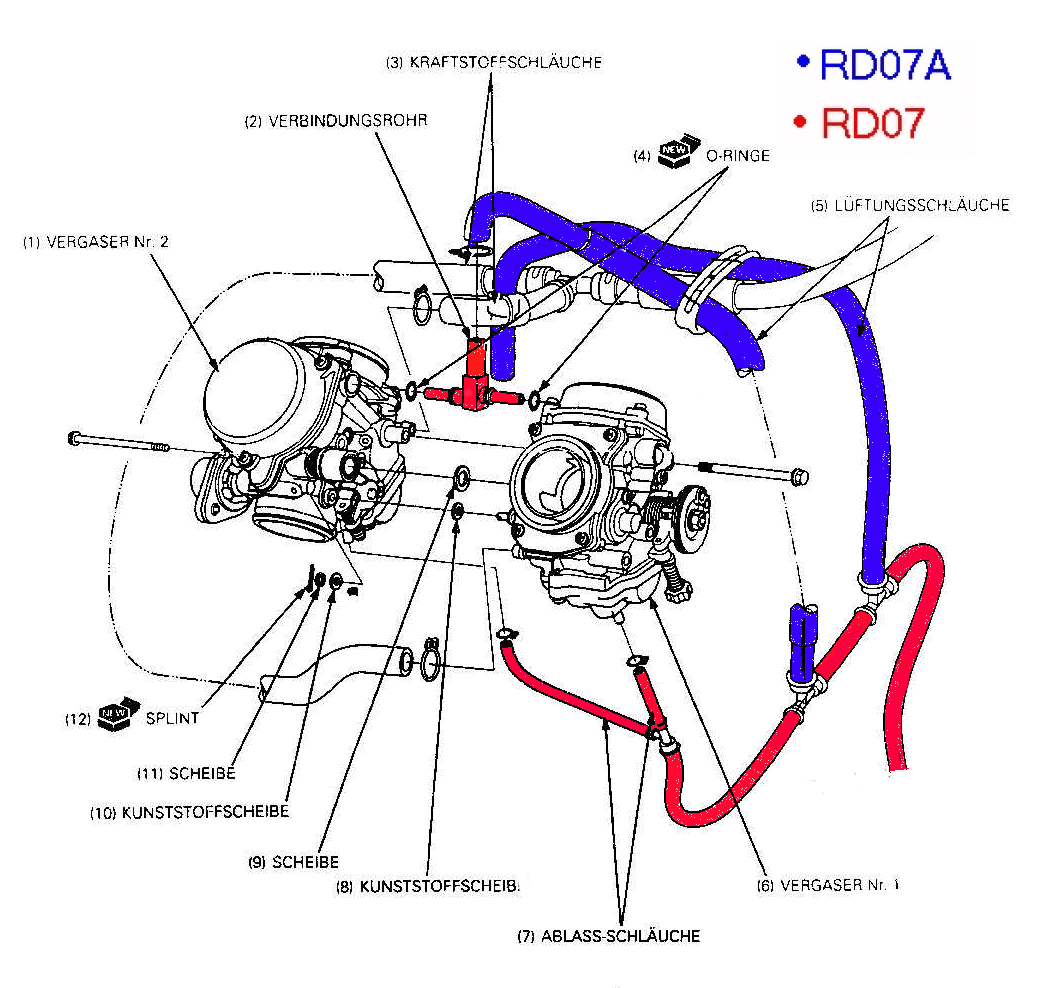Starting problems
Africa Twin riders often report problems while starting their bike after a
longer time of standing around (three days and more). Several attempts have
to be taken to start the engine.
Beginning with the 97 model Honda seems to have found a solution for that
and it is easy to implement even on older Africa Twins
(tested on RD03, RD04, RD07).
The changes from Honda at the RD07A
The source of the starting problem is, that the fuel in the carburator
gets lost after some days of not running the engine.
The Solution:
Mount the parts from Honda made for the RD07A.
They have changed the ventilation of the carburator.
Here are the Parts and the prices in DM you need (as in 1997):
| Part. no. |
Name |
Pieces |
Price (DM) |
| 19332-PH9-000 | Joint, Three Way | 2 | 10,86 |
| 16197-MAY-640 | Tube Comp. | 1 | 8,28 |
| 16198-MAY-640 | Tube | 1 | 4,57 |
| 16199-MAY-640 | Tube | 1 | 8,71 |
| 17194-MN5-000 | T Connector | 1 | 9,91 |
| 95005-701-2050 | | 2 | 14,48 |
| 95002-700-00 | Clamp C11 | 10 | 0,52 |
Of course you can also use three standard t-connectors and
about 1m of fuel pipe (6mm), available at every accessory shop.
The costs are about 10,-- EUR.
The old and new ventilation system in comparison:

The Problem
The floating chambers of the 2 carburetors are connected together
on their upper side and out from these connection looks a short
pipe in upper direction. This pipe is about 3cm long and it`s opened
to its upper side, for getting air to the floating chamber's
direction.
As far so well.
If the bike has not been started a couple of days (3-4 days) the fuel will
evaporate over this pipe - Thats normal because fuel is a volatilely liquid.
Now, if u`r trying to start your AfricaTwin after a few days out of order,
she will not start immediately because of the fuel pump has to pump new fuel
into the floating chambers until the bike comes back to life again.
The Solution
The engineers at Honda built the following modification from RD07
into the RD07a.
Connect a tube from the carburetors connections upper opening, mentioned
before, to the other ventilation tube (ending at the back side of this
aluminium protection sheet metal below of the engine (you know what I mean?)
This ventilation tube has to be cut through at the most suitable place for
being connected through a T-connector with the upper coming, new tube.
Actually now everything is finished, because the gasoline cannot evaporate
any longer, because it cannot escape upward any longer.
But if Honda`s Engineers do something, then they do it right:
If u`re mud-jumping with your AT, it could eventually happen that this
ventilation tube could get clogged. For still having the floating chambers
being ventilated, here comes part 2 of this trick:
You have to cut the tube and set a second T- Connector in short distance of
your first done cut.
One new tube which should be leaded to the upper side and ends somewhere
near the point where the first tube has been stuck on has to be connected on
the opened end of the T-connector.
This second Tube has to get an open end somewhere in protected area near the
carburetors. This guarantees the floating chambers to geht air if
everything beneath is clogged.
That was the whole Trick:
Now the fuel cannot evaporate anymore and your Twin will start immediately,
even after 14 days standby. She will do it immediately after short pushing
the button.
The needed parts had been mentioned in top of the page, and in addition
every single honda dealer has got a pic from this whole action on
micro-fiche, but u have to pay for this moidification for youself.
This modification takes about 30 minutes working time and u should remove
the main tank for seeing what u`re working at.
Stefan
Translation:
Harry (harryjordan@hotmail.com)
Addon by Arjen Hoen:
I owe you a big THANKS for the simple and effective measure. The information
on www.atic.org is also most helpful. However I do want to add some info:
Firstly I noted different diameters of the original carburator tubes which
have to be connected (>6 mm for the ventilation and 4 mm for the overflow
tube). I went to my local autoshop to get the necessary pieces and this is
what I finally used:
- 0,5 m fuel tube, diameter 4 mm ((inside!)
- two T-connectors of 4 mm
Costs: approx. 5 euro's! ;-]
I made the connection between the original ventilation and the new tube
simply by forcing it 5 cm. inside. The outer diameter of the new tube
corresponded with the inner diameter of the existing ventilation! 'Natural'
resistance did the trick in my case...
Arjen Joen
| 